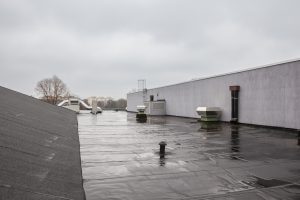
 Flatroofs are designed to be level or have a slight slope to allow water to flow towards drainage outlets or gutters. However, over time, debris, leaves, and other materials can accumulate on the roof, blocking these drainage systems and causing water to accumulate. When water accumulates on a flat roof, it can lead to a variety of problems, including:
- Roof Damage: Prolonged water accumulation on a flat roof can cause damage to the roofing material, leading to leaks and other problems.
- Structural Damage: Water accumulation on a flat roof can also cause damage to the underlying structure, such as weakening the roof decking or causing rot in the framing.
- Health Risks: Standing water on a flat roof can become a breeding ground for mosquitoes, mold, and other harmful organisms, which can pose a health risk to occupants of the building.
How to Drain Water from a Flat Roof
There are several methods for draining water from a flat roof, depending on the size and shape of the roof and the specific drainage system in place. Here are some common methods:
- Scuppers: Scuppers are openings in the edge of the roof that allow water to drain off the roof and into downspouts or gutters. To ensure that scuppers remain clear and functioning, they should be inspected and cleaned regularly.
- Gutters: Gutters are another common method for draining water from a flat roof. They are typically installed along the perimeter of the roof and slope towards downspouts, which carry the water away from the building. Gutters should be inspected and cleaned regularly to prevent clogs and water accumulation.
- Internal Drains: Some flat roofs have internal drains, which are located in the center of the roof and allow water to flow into pipes that carry it away from the building. These drains should be inspected and cleaned regularly to prevent clogs and ensure proper functioning. Call your local roofer for maintenance.
- Tapered Insulation: Tapered insulation is a system of layered insulation that is sloped to allow water to flow towards drainage systems. This method can be used in combination with scuppers, gutters, or internal drains to provide effective drainage.
Tips for Maintaining Flat Roof Drainage
Maintaining a flat roof’s drainage system is key to preventing water accumulation and the problems it can cause. Here are some tips for keeping your flat roof drainage system functioning properly:
- Inspect and Clean Regularly: Regular inspections and cleaning of scuppers, gutters, and drains can prevent clogs and ensure that water is flowing freely off the roof.
- Remove Debris: Leaves, sticks, and other debris can accumulate on flat roofs and clog drainage systems. Regularly removing debris can prevent clogs and ensure proper drainage.
- Monitor Slope: Over time, the slope of a flat roof can change due to settling or other factors. Monitoring the slope and adjusting insulation or drainage systems as needed can prevent water accumulation.
- Hire a Professional: Maintaining a flat roof’s drainage system can be a complex task that requires specialized knowledge and equipment. Hiring a professional roofing contractor to inspect and maintain your roof’s drainage system can help ensure that it remains in good condition.
In summary, draining water from a flat roof can be simple but regular maintenance is important to prevent serious damage to your home or business. By following these tips and taking proper safety precautions, you can keep your flat roof in good condition and extend its lifespan.
For regular roof maintenance and draining, call Florence Roofing Pros!
Florence Roofing Pros
Florence, SC 29501
(843) 773-4787
http://florenceroofingpros.com
Serving: Lake City, Marion, Darlington, Hartsville, Florence

No comments:
Post a Comment